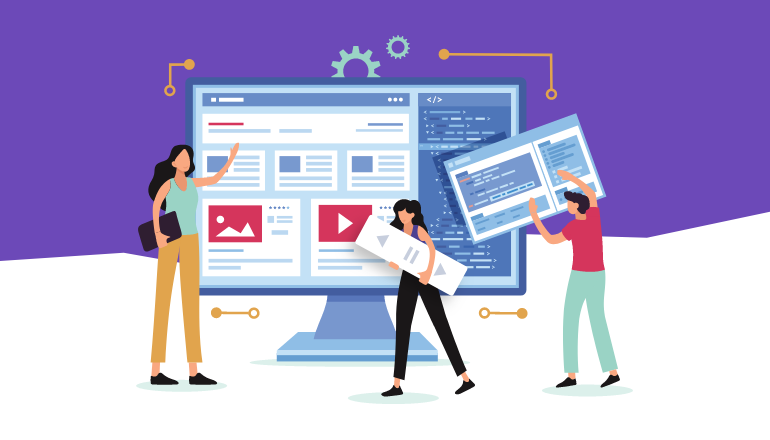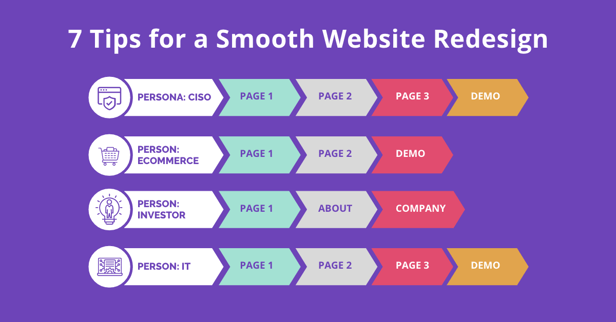
Whether a website is underperforming or you’re ready for a new look, it’s vital that you take time to prepare the groundwork before jumping into the redesign. Marketing managers spend hours creating and honing the messages they want to convey, but if the project jumps directly from writing content to designing pages, important steps will be missed, leading to a website that is ineffective or off-brand.
At Penguin, we've managed 100s of website redesigns and here are seven essential tasks to do over the course of your redesign to ensure that your site launches smoothly and is positioned to represent your brand as effectively as possible.
1. Start by reviewing your existing site
Your second stop in preparing for your website redesign is your own site. Create two lists – one with the things you like about the existing site, and the second with the elements that aren’t working. Create a full sitemap, listing every page with a word or two about what’s on the site.
Going through the site map, identify which pages you want to keep. This needs to be done before the team starts creating content for the new site.
Another area you need to research is your buyer personas’ journeys. Create a customer journey map for the different personas you hope to attract, noting the type of content and messaging that appeals to different groups of people.

For example, if you have a SaaS product that helps marketing departments generate additional leads, you may have three different personas looking at your site.
- Marketing personnel interested in what the system does
- IT personnel who need to see how the system fits with their existing IT
- Investors interested in learning about the company
As each one of these personas has different goals and interests, you will want to incorporate the best website journey to meet each of their needs.
2. Move on to external research
The next step in your redesign journey takes place on your top competitor’s websites. While reviewing their sites take notes of the way your competitors set up navigation, how they present information, and their calls to action. In addition to finding ideas that you like, include things you come across that you want to avoid. That will ensure that your designer doesn’t unknowingly add those types of elements to your site.
As an added benefit, when you review competitor sites shortly after reviewing your own site, the elements in your site will be fresh in your mind. This will make it easier to compare the sites, helping guide the choices you make in website content.
3. Strategize your timeline
A lot of companies make the mistake of picking a launch date for their redesign rather than mapping out a complete timeline for the different stages of the project. Creating a timeline will give you a realistic launch date that will effectively challenge your team.
While creating your timeline, prioritize pages and consider using a growth-driven design strategy. That way, your most important pages will be redesigned and launched, while less visible pages don’t delay the project. Not only will you get your site updated faster, but you’ll get insight one the new design’s effectiveness while the project is still underway.
Work collaboratively with your design team instead of dictating timelines. Use milestones, project expectations, and weekly updates to track your progress and move toward the finish. You’ll want to be realistic, by building in time for unexpected delays.
One last tip with timelines – plan your redesign to coincide with slow periods. That will help ensure that SMEs are available when needed, and you don’t get caught with a half-done website the day before your biggest customer event.
4. Match expectations from the start
Website redesigns are complex projects that involve multiple work teams. You will likely need input from marketing, product, design, HR, and dev teams. Even if you’ve outsourced the design of the site to a third party, you still need to align your internal teams and expectations for an on-time site launch.
Set expectations on design, development, communication, timeline, and feedback with all the groups involved. Expectations should be based on a relative timeline, as delays or expedited stages can impact when you need the involvement of others in the process.
5. Create your brand book
A lot of companies don’t see value in developing their brand book, but it functions as a guide to ensure consistency across your brand. Your brand book will be used long after your redesign, allowing multiple designers to maintain a consistent brand voice in all your subsequent collateral materials.
The brand book can be written either before the redesign or developed by the design team based on the graphic decisions made over the course of the project.
Your brand book should include:
- Your logo and any acceptable variations, such as social media icons, stacked versions, and directives for different backgrounds
- Color palettes, including the primary colors in your logo, three-to four primary colors for your designer to use, and a handful of secondary colors to use when needed
- Typography section, complete with acceptable fonts, styles, sizes, and hierarchy. Make sure your fonts are licensed for web use, while bearing in mind that custom fonts might cause a delay in your page loading
- Imagery, which can be guidelines for images, or even a curated library of acceptable images
6. Test your site
As pages are completed, assign someone to review the quality of the site. This person or team will compare the designed page to the agreed-upon scope, checking layout, content, fonts, images, device compatibility, and screen size adaptability. You may find value from sharing your site externally. The multiple perspectives, especially from trusted clients or industry experts, will help in strengthening the site.
Additionally, they will click every link and fill out every form, making sure that the site performs correctly.
7. Keep on optimizing
Even after you have successfully launched your updated site, your work is never over. Keep a close eye on your performance analytics to measure effectiveness with tools like Google Analytics and Hotjar to develop a better understanding of your visitors’ interests and needs.
Hotjar uses heatmaps to show how users are viewing your site, while Google Analytics lets you see a number of insights, including:
- Identify best and poorest performing pages
- Analyze your audience
- Analyze user behavior
- Check devices used on your site
- Check site speed
Using the data from these types of tools, you can continually analyze, report on, and optimize your website, to create an effective tool for your business.
Get your redesign right the first time
Website redesigns are time-consuming, complex, and absolutely necessary to maintain your competitive edge. Follow the tips I’ve included here, and you’ll set yourself up for a successful relaunch of your site.
Penguin Strategies has been listed as one of the Top 20 B2B Website Design Companies
Looking for an experienced partner to help manage your website redesign? Partner with Penguin Strategies, and we’ll get your site done right.

by Dani Paz on March 08, 2021
Dani is a Content Marketing & Marketing Automation Specialist and a former professional soccer player.





